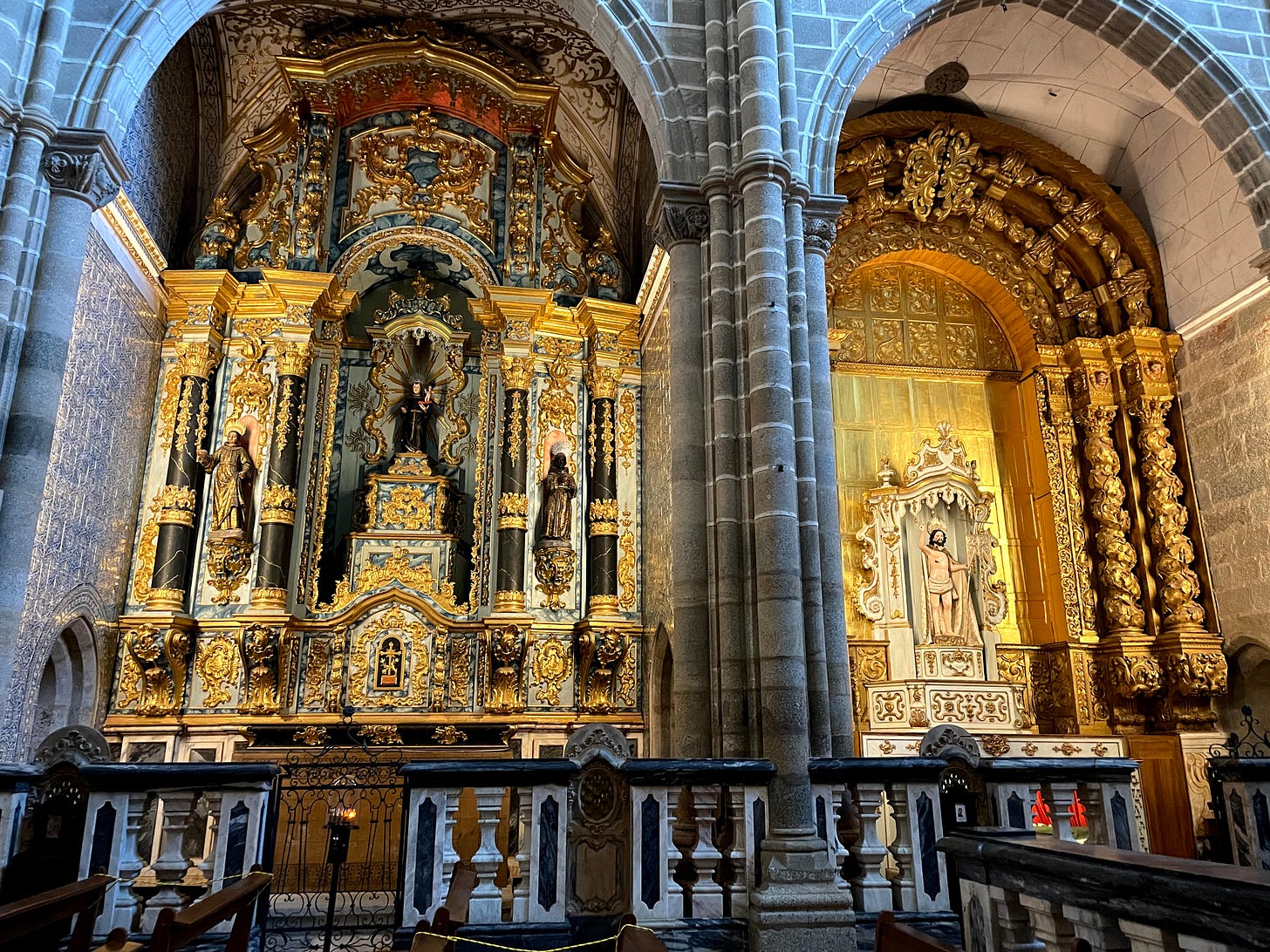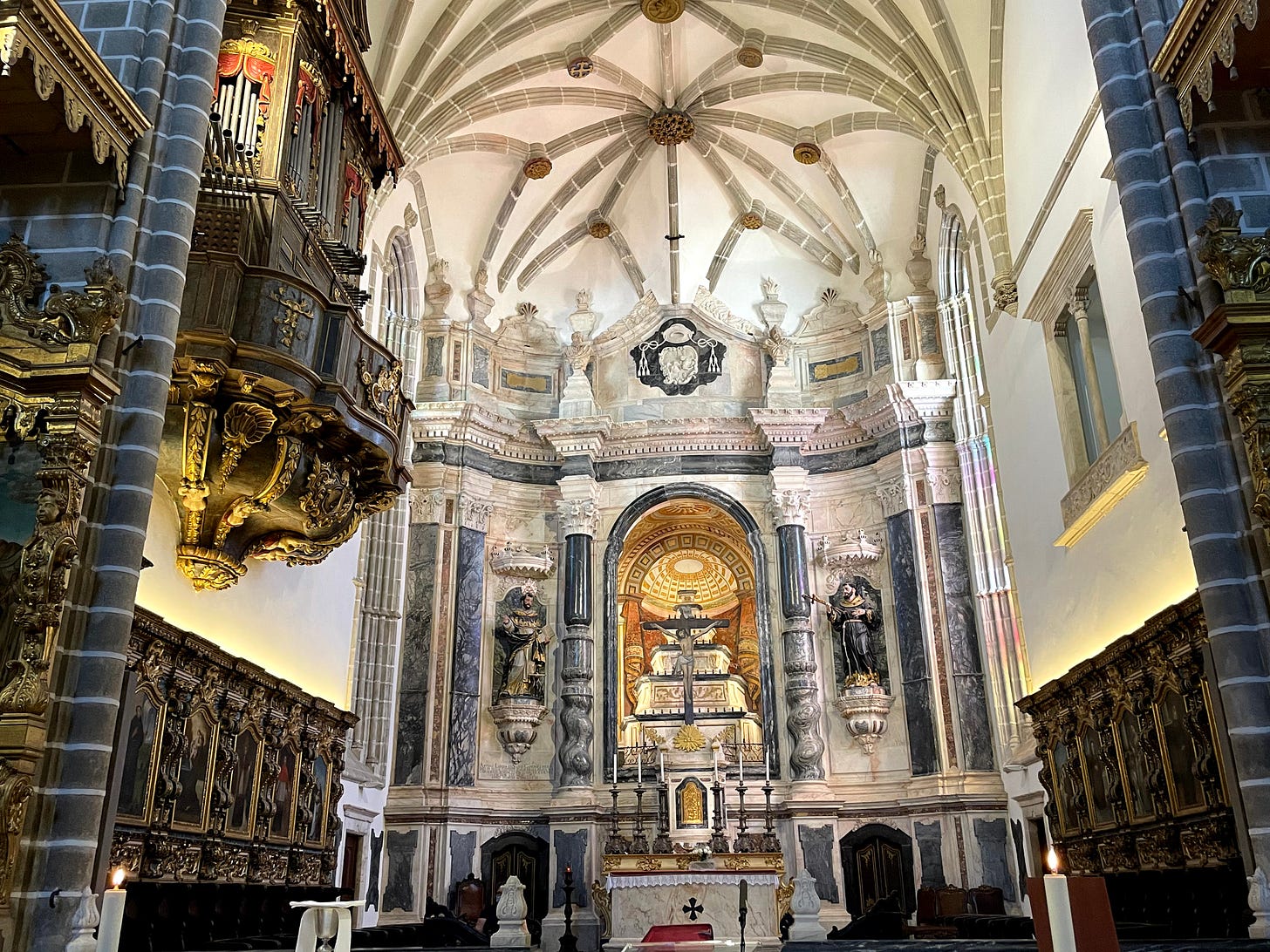Denise had read about Évora on travel blogs. I had seen a Youtube video of A Capela dos Ossos (The Chapel Of Bones). Our banker, Frederico, had also mentioned it as a necessary excursion. So off we went.
First a Few Recommendations
Please note: we are not among the bloggers or YouTubers that get free places to stay and free food by promoting a business. So these recommendations are solely based upon our experience.
We choose to stay at The Noble House. I chose it because it was inside the walls of the city and located next to one of its largest cathedrals. We were pleasantly surprised to find that they upgraded us to their Cathedral suite. It could easily be a one-bedroom apartment as it had a large living room, fully equipped kitchen, generous bedroom, and bath. But its most spectacular feature was the view from our living room window.
The second recommendation, which I will write about more in a future post: make sure you eat at Enoteca Cartuxa. They were recommended by our hotel but were already full for dinner on both evenings. So we settled for a late lunch on Friday. We enjoyed some of their wine with our meal and left with 6 bottles. Finally, and this should come as no surprise to our regular readers, take the free walking tour. Sandra loves her city and weaves a comprehensive knowledge of history, architecture, culture, and religion into her two-hour tour.

Igreja de São Francisco
During the tour, we stopped at the Church of St Francis. That’s Sandra above with Denise (you know her by her now-famous hat) pointing out a unique feature of the front facade. You’ll note that the entryways are not symmetrical … which is odd. There is the Gothic, the Manueline in the center, and then a distinctively Moorish arch on the right. The church even has spiral conical shapes on the top of the roof. As the church was built (1475-the 1500s) during the Inquisition, could it be an architectural protest to religious intolerance?
When you step into the church, you find opulence funded by Noble’s efforts to assure their status in eternity. Along the sidewalls (above), each “donor” had a say in the design of their chapel. We learned that many were not satisfied with the colors of marble available, and employed faux painters to paint on top of the marble the exact color and veining they preferred. We also learned that as restoration efforts were underway they found designs that had been painted over years earlier. Painstaking efforts have been made to display what is below. There are more photos on our Facebook page.
Also of note, the “groin-vaulted nave” opens the space by intersecting two barrel vaults allowing the huge space to be supported only at the four corners. Imagine the mind that had the ability to properly engineer this 6 centuries ago. Note the organ on the left, and the King’s window directly across from the organ. I wondered if he brought earplugs to mass. Later in the day, we peered through the King’s window from the Chapel of Bones.
Chapel of Bones
We circled back to the Chapel of Bones on our own after lunch. While the chapel itself is small it is well worth the 5,00€ entry fee. The chapel is just to the right of the Church of St Francis and was originally the monks’ dorm. There are small windows on one side of the building providing just enough light to safely navigate. Approximately 5000 bones and skulls collected from graves in the local churches are carefully cemented over the walls and pillars. There are also two desiccated corpses in glass display cases. The ceiling is painted with skull motifs and the phrase "Melior est die mortis die nativitatis” which is from Ecclesiastes “Better is the day of death than the day of birth".

One wonders what inspired bone chapels. You see, there are at least six in Portugal. It is thought that the 17th-century Franciscan friars responsible for this one in Évora were hoping to communicate the temporariness and fragility of human life. It reminds me of why I picked up life in the U.S. and came to Portugal.
More Reader Feedback: As a third of my readers took the time to answer the survey, I want to continue to share with you some of the highlights. One of the questions was “How did you find me?” The pie chart below tells the story.
35% the largest blue area represents friends and family that knew us before we moved to Portugal. The red area to its left (about 8%) found us because a reader recommended the site to them. The orange area (27.5%) found us through social media. The percentage is actually higher because many of those tiny slices referenced Facebook or Twitter or Instagram. [The rest of those tiny slices reference in different ways a blog I used to have called RVPicklers (when we had our motorhome and traveled around the U.S. playing pickleball).]
I am sharing this with you in hopes that you will help me grow our readership. If there is a post that you like…please share it on social media! If you participate in any expat forums, sharing a post there would be particularly helpful. Muito obrigada!










We hear you on your last line of your blog. :-)
The last line of your blog was bone-chilling